Technical Aspects of Printing on Metal with a UV Flatbed Printer
Technical Aspects of Printing on Metal with a UV Flatbed Printer
In the realm of digital printing, advancements have led to the exploration and utilization of various unconventional substrates, including metal. The use of UV flatbed printers for printing on metal surfaces has gained significant popularity due to their ability to produce high-quality, durable prints with intricate details. This article delves into the technical aspects of printing on metal using a UV flatbed printer, exploring the printer’s components, the printing process, substrate preparation, ink properties, curing mechanisms, design considerations, and post-processing techniques.

UV Flatbed Printer Components
UV flatbed printers are designed to accommodate flat or slightly curved surfaces, making them ideal for printing on metal sheets or panels. These printers typically consist of several key components:
Print Bed: The flat, horizontal platform where the metal substrate is placed for printing. It is usually adjustable to accommodate different sizes and thicknesses of materials.
Ink Delivery System: This includes print heads that deposit ink onto the metal surface. UV flatbed printers often use piezoelectric or thermal inkjet technology for precise ink droplet control.
UV Curing System: UV lamps or LED arrays are integrated into the printer to instantly cure the ink as it is deposited. This rapid curing process is crucial for achieving durable prints on metal.
Control Software: Sophisticated software manages the printing process, including ink deposition patterns, color management, and printer settings adjustments.
Printing Process
The printing process involves several steps, each critical to achieving optimal print quality on metal:
Substrate Preparation: Metal surfaces must be clean, dry, and free from oils, dust, or any contaminants that could affect ink adhesion. This often involves degreasing, sanding, or using chemical cleaners.
Design and File Preparation: High-resolution digital files are created or obtained, typically in formats such as PDF, AI, or EPS. The design is then processed through the printer’s software for color correction, scaling, and layout adjustments.
Ink Loading: UV-curable inks specifically designed for metal printing are loaded into the printer’s ink delivery system. These inks are formulated to adhere to metal surfaces and withstand the curing process.
Printing: The metal substrate is placed on the print bed, and the printer deposits ink onto the surface following the design specifications. UV lamps or LEDs immediately cure the ink, solidifying it and creating a durable print layer.
Multi-Pass Printing: For designs requiring vibrant colors or high opacity, the printer may perform multiple passes, depositing and curing ink in layers.
Ink Properties
UV-curable inks used in flatbed printing on metal possess unique properties that contribute to print quality and durability:
Fast Curing: UV inks cure rapidly when exposed to UV light, allowing for instant ink drying and reduced risk of smudging or bleeding.
Chemical Resistance: Once cured, UV inks exhibit resistance to chemicals, solvents, and water, making them suitable for outdoor or industrial applications.
Flexibility and Adhesion: UV inks are formulated to adhere to metal surfaces while maintaining flexibility, preventing cracking or peeling when the metal is bent or shaped.
Color Gamut: A wide color gamut is achievable with UV inks, allowing for vibrant, accurate reproductions of complex designs.
Curing Mechanisms
The curing process is a critical aspect of printing on metal with UV inks. UV lamps or LED arrays emit ultraviolet radiation that initiates a photochemical reaction in the ink, transforming it from a liquid to a solid state. This process occurs in seconds and is essential for:
Ink Drying: Instantly drying the ink to prevent smudging or bleeding.
Durability: Enhancing the print’s resistance to abrasion, chemicals, and fading.
Adhesion: Promoting strong bonding between the ink and the metal surface.
Design Considerations
When designing for metal printing with a UV flatbed printer, several factors should be considered:
Resolution: High-resolution designs ensure crisp, clear prints, especially for intricate details or fine text.
Color Contrast: Consider the contrast between the ink colors and the metal substrate for optimal visibility.
Expansion and Contraction: Metal may expand or contract with temperature changes, so designs should account for potential dimensional shifts.
Surface Texture: The metal’s surface texture can affect ink adhesion and print quality. Smooth surfaces generally yield better results.
Post-Processing Techniques
After printing, post-processing techniques can further enhance the print’s durability and appearance:
Heat Treatment: Applying heat can further cure the ink, enhancing its adhesion and chemical resistance.
Clear Coating: Applying a UV-curable clear coat can provide additional protection against abrasion and UV degradation.
Cutting and Finishing: Depending on the application, the printed metal sheet may be cut, bent, or shaped using appropriate tools and techniques.
Conclusion
Printing on metal with a UV flatbed printer offers a versatile and efficient method for producing high-quality, durable prints. Understanding the technical aspects of this process, from printer components to ink properties and post-processing techniques, is crucial for achieving optimal results. As technology continues to advance, the capabilities of UV flatbed printing on metal will likely expand, offering even greater potential for creative and industrial applications.
